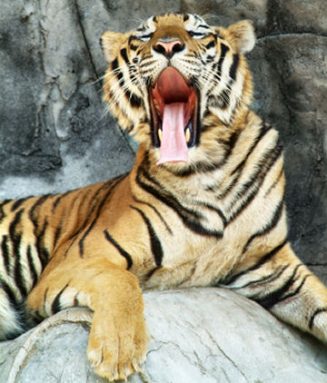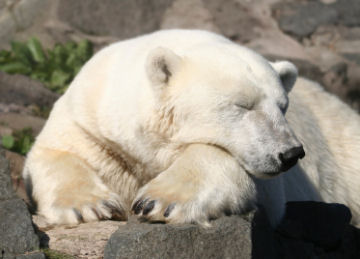Why cats nap and whales snooze
Animals need sleep and sometimes achieve it under what we'd consider extraordinary conditions.
At first, it may seem like a treat to stay up late—but the next day will be no picnic. There’ll be yawning, heavy limbs, and a cranky disposition.
At times like these, the desire to sleep can feel overwhelming.
And it should.
Growing kids need sleep, as do people of all ages. Indeed, research shows that health and safety both suffer when we try to get by with too little shut-eye. So it’s fortunate that our bodies do such a good job of alerting us when it’s time to hit the sack.
Like people, other animals also take time out to rest. You’ve probably seen a lion dozing at the zoo, or maybe watched your dog snooze away, curled up in its bed. In fact, sleep is a necessity for every animal that’s ever been studied. This includes whales, octopuses—even fruit flies.
How long animals slumber, though, varies widely. Elephants and giraffes sleep only about 2 to 4 hours a day, while bats and opossums may nod off for up to 20 hours. By studying similarities and differences in when and how long various animals sleep, researchers hope to better understand why the need for rest is critical to creatures throughout the animal kingdom.
 |
|
Getting sleepy? Yawning is just one trait we share with many animals that are tired. |
| iStockphoto |
What is sleep?
It’s obvious what your mom means when she says it’s time to go sleep, But how do scientists describe this restful period? When we sleep, our eyes usually close and we lose consciousness. You might even think that your brain shuts down. But it doesn’t.
By attaching sensors to the surface of a sleeper’s scalp, researchers can listen in on patterns of electrical waves within the brain. Such measurements show that the patterns of these waves change throughout the night as the body alternates between two types of sleep.
In the first type, brain activity slows as the body enters an especially deep sleep. In the second type, known as rapid-eye movement (REM) sleep, our eyes flutter rapidly under their lids (hence the name)—and our brains become almost as active as they are when we’re awake. This period is also when we dream.
Unlike reptiles, amphibians, and fish, all land mammals and birds experience this type of resting. “REM sleep is quite a mystery,” says Jerome Siegel, who studies slumber in animals at the University of California, Los Angeles. Researchers don’t know why people or any other animals do it.
One thing REM-sleeping animals have in common, though, is that they’re all relatively intelligent. Researchers wonder if the need for REM sleep, with its buzzing brain activity, has something to do with that.
 |
|
The need for sleep is important, which is why many animals—including cats and dogs—grab a nap when there’s little need for activity. |
| iStockphoto |
“We have always joked and used the term ‘birdbrain’ to indicate that somebody’s stupid,” says Niels Rattenborg, who studies bird sleep at the Max Planck Institute for Ornithology in Starnberg, Germany. But birds are better at certain intelligence tests than are some mammals, so perhaps “birdbrain” should be considered a compliment, he says.
On the other hand, Siegel has found that the duck-billed platypus, which isn’t a particularly brainy animal, has “spectacular” REM sleep—twitching its bill and legs throughout this stage. And some of the smartest animals—dolphins and whales—experience no REM sleep. So its purpose remains a puzzle.
Strange sleep
That’s not the only baffling thing about the sleep habits of dolphins and whales. A second mystery is that just half of their brain dozes—and one eye closes—at a time. Keeping partly alert may be one way that these mammals protect themselves in the open ocean, Siegel says: “They have no safe place to sleep.”
Ducks do something similar. When sleeping together, the birds on the edge of the group slumber with the outside eye open and half of their brain awake—presumably to keep watch while the other half of their brain snoozes.
Some birds may even sleep while flying. Rattenborg’s team has designed instruments to attach to birds that spend most of their life in flight. Using these tools, the scientists will measure the birds’ brain waves as the animals fly, looking for signs that they might nap in the air.
The fact that all animals make time for sleeping, even under potentially dangerous circumstances, suggests that sleep must serve a crucial function. And indeed, some evidence suggests that sleep is essential for learning and forming permanent memories (see “Memories Are Made with Sleep”).
But sleep may also be primarily a way for animals to save energy and stay out of harm’s way, Siegel says. This may help explain why meat-eating critters sleep more than herbivores, which are animals that dine solely on plants. Herbivores like cows and zebras need to spend more time searching for and grazing on food than do meat eaters, such as lions and other big cats. A lion that has just fed on an antelope won’t have to eat again for several days. So a big cat might be better off snoozing for a spell after it eats, rather than prowling around and risking injury.
 |
|
Top predators, like this polar bear, may slumber for a long time after a major meal. |
| iStockphoto |
But that’s just an educated guess, really, based on a growing number of observations. Scientists need to study the animals they’ve already looked at in greater detail. And they need to study other animals as well before they can fully understand the benefits of sleep and identify which benefits are most important for a particular species.
One thing is certain: ample slumber is essential to health and learning (see “Sleep to Remember Places and Routes”). So give in when a strong urge to sleep hits, and catch plenty of ZZZ’s.
Going Deeper:







